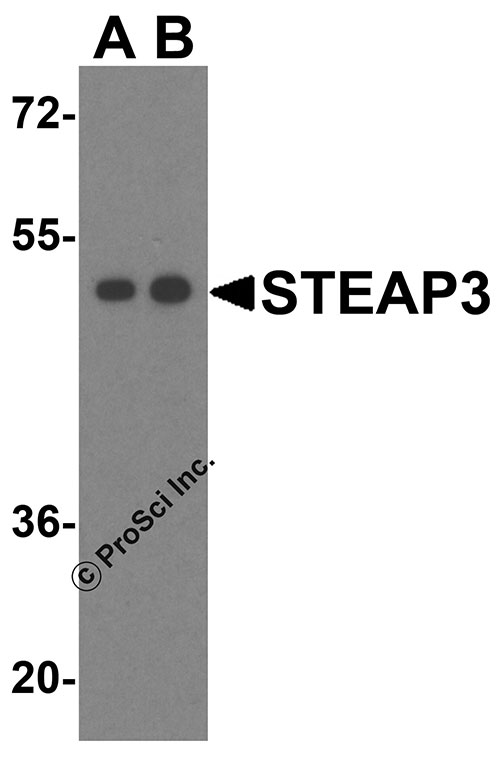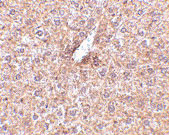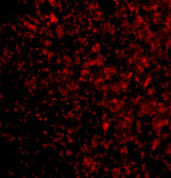STEAP3 Antibody
- SPECIFICATION
- CITATIONS
- PROTOCOLS
- BACKGROUND

Application
| WB, IHC-P, IF, E |
|---|---|
| Primary Accession | Q658P3 |
| Other Accession | AAH95421, 127801437 |
| Reactivity | Human, Mouse, Rat |
| Host | Rabbit |
| Clonality | Polyclonal |
| Isotype | IgG |
| Calculated MW | Predicted: 55 kDa Observed: 51 kDa |
| Application Notes | STEAP3 antibody can be used for detection of STEAP3 by Western blot at 1 - 2 µg/mL. Antibody can also be used for immunohistochemistry starting at 2.5 µg/mL. For immunofluorescence start at 20 µg/mL. |
| Gene ID | 55240 |
|---|---|
| Target/Specificity | STEAP3; This STEAP3 antibody does not cross-react with other STEAP proteins. |
| Reconstitution & Storage | STEAP3 antibody can be stored at 4℃ for three months and -20℃, stable for up to one year. As with all antibodies care should be taken to avoid repeated freeze thaw cycles. Antibodies should not be exposed to prolonged high temperatures. |
| Precautions | STEAP3 Antibody is for research use only and not for use in diagnostic or therapeutic procedures. |
| Name | STEAP3 |
|---|---|
| Synonyms | TSAP6 |
| Function | Integral membrane protein that functions as a NADPH-dependent ferric-chelate reductase, using NADPH from one side of the membrane to reduce a Fe(3+) chelate that is bound on the other side of the membrane (PubMed:26205815). Mediates sequential transmembrane electron transfer from NADPH to FAD and onto heme, and finally to the Fe(3+) chelate (By similarity). Can also reduce Cu(2+) to Cu(1+) (By similarity). Mediates efficient transferrin-dependent iron uptake in erythroid cells (By similarity). May play a role downstream of p53/TP53 to interface apoptosis and cell cycle progression (By similarity). Indirectly involved in exosome secretion by facilitating the secretion of proteins such as TCTP (PubMed:15319436, PubMed:16651434). |
| Cellular Location | Endosome membrane {ECO:0000250|UniProtKB:Q8CI59}; Multi-pass membrane protein. Note=Localizes to vesicular- like structures at the plasma membrane and around the nucleus |
| Tissue Location | Expressed in adult bone marrow, placenta, liver, skeletal muscle and pancreas. Down-regulated in hepatocellular carcinoma. |

Thousands of laboratories across the world have published research that depended on the performance of antibodies from Abcepta to advance their research. Check out links to articles that cite our products in major peer-reviewed journals, organized by research category.
info@abcepta.com, and receive a free "I Love Antibodies" mug.
Provided below are standard protocols that you may find useful for product applications.
Background
STEAP3 Antibody: The six-transmembrane epithelial antigen of prostate 3 (STEAP3) is a member of a family of metalloreductases identified as cell-surface antigens in prostate tissue. Similar to two other members of the STEAP family (STEAP 2 and STEAP4), STEAP3 promotes both iron and copper reduction. STEAP3 is highly expressed in hematopoietic tissues and colocalizes with the transferrin endosome. Overexpression of STEAP3 stimulates iron reduction; mice lacking STEAP3 are deficient in erythroid ferrireductase activity, suggesting that STEAP3 is an endosomal ferrireductase required for transferrin-dependent iron uptake in erythroid cells.
References
Ohgami RS, Campagna DR, Greer EL, et al. Identification of a ferrireductase required for efficient transferrin-dependent iron uptake in erythroid cells. Nat. Genet.2005; 37:1264-9.
Ohgami RS, Campagna DR, McDonald A, et al. The Steap proteins are metalloreductases. Blood2006; 108:1388-94.
Graham RM, Chua ACG, Herbison CE, et al. Liver iron transport. World J. Gastroenterol.2007; 13:4725-36.
If you have used an Abcepta product and would like to share how it has performed, please click on the "Submit Review" button and provide the requested information. Our staff will examine and post your review and contact you if needed.
If you have any additional inquiries please email technical services at tech@abcepta.com.













 Foundational characteristics of cancer include proliferation, angiogenesis, migration, evasion of apoptosis, and cellular immortality. Find key markers for these cellular processes and antibodies to detect them.
Foundational characteristics of cancer include proliferation, angiogenesis, migration, evasion of apoptosis, and cellular immortality. Find key markers for these cellular processes and antibodies to detect them. The SUMOplot™ Analysis Program predicts and scores sumoylation sites in your protein. SUMOylation is a post-translational modification involved in various cellular processes, such as nuclear-cytosolic transport, transcriptional regulation, apoptosis, protein stability, response to stress, and progression through the cell cycle.
The SUMOplot™ Analysis Program predicts and scores sumoylation sites in your protein. SUMOylation is a post-translational modification involved in various cellular processes, such as nuclear-cytosolic transport, transcriptional regulation, apoptosis, protein stability, response to stress, and progression through the cell cycle. The Autophagy Receptor Motif Plotter predicts and scores autophagy receptor binding sites in your protein. Identifying proteins connected to this pathway is critical to understanding the role of autophagy in physiological as well as pathological processes such as development, differentiation, neurodegenerative diseases, stress, infection, and cancer.
The Autophagy Receptor Motif Plotter predicts and scores autophagy receptor binding sites in your protein. Identifying proteins connected to this pathway is critical to understanding the role of autophagy in physiological as well as pathological processes such as development, differentiation, neurodegenerative diseases, stress, infection, and cancer.




